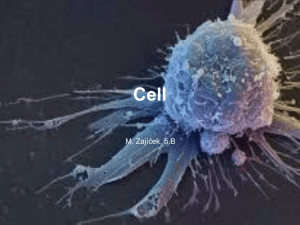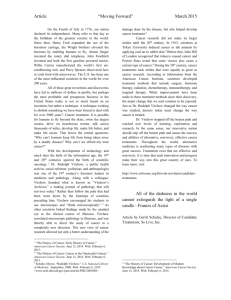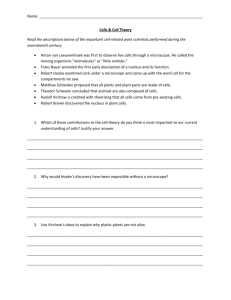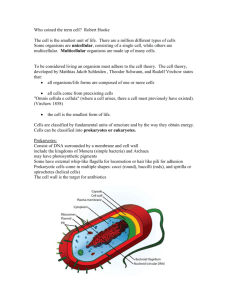Social Medicine Intro - The Social Medicine Portal
advertisement
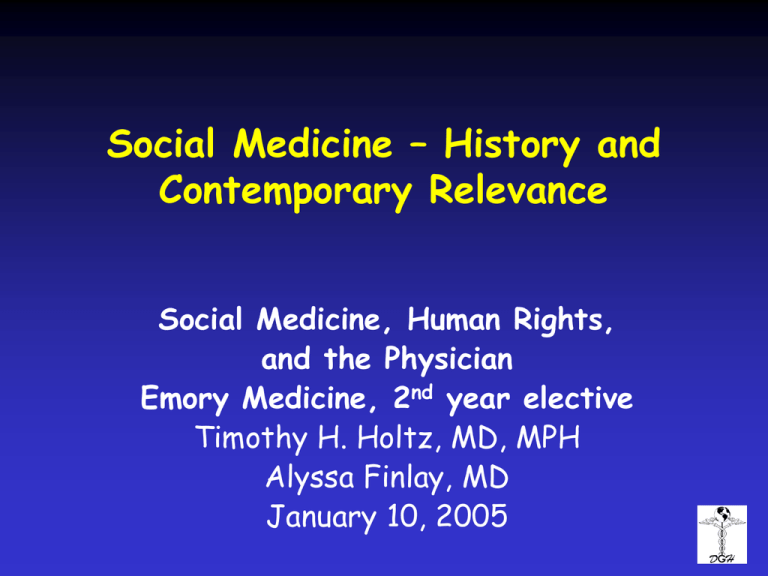
Social Medicine – History and Contemporary Relevance Social Medicine, Human Rights, and the Physician Emory Medicine, 2nd year elective Timothy H. Holtz, MD, MPH Alyssa Finlay, MD January 10, 2005 Summary Components of social medicine History Contemporary examples Advocacy and social justice Components Medical care Preventive medicine Public health Social well-being Consequence Ensure universal and equitable access to and appropriate use of an effective and efficient medical care system Encourage preventive medicine Strengthen governmental health authorities Increase resources for the promotion of social well-being Recognition Medical professionals should recognize a patient as a social creature, that many aspects of their lives impact upon their health, their exposure to illness and illnessproducing behaviors, and their “agency” (capacity to mobilize resources to improve well-being) Consequence A socially-oriented physician would take action to improve housing, nutrition, educational opportunities, and employment opportunities; combat racism and discrimination; eliminate poverty; and alter the inequities and inadequacies of the medical care delivery system…and in society at large Change pathogenic situations in the community to protect community at large May incur social and professional opprobrium (ridicule/disgrace) May face resistance in using your professional role to ameliorate pathogenic social situations Ibsen’s Dr. Stockman = Enemy of the People Ethics and responsibility Modern medicine should encompass expanded notions of the physician’s responsibility to society Physicians should contemplate the global forces that cause or contribute to disease or prevent its amelioration Physicians can adopt an advocacy role in pursuing change that will net result in health improvements (grand scope) Contemporary Social Medicine Galdston – British theorist Rosen – historian Silver – medical historian Terris – journal editor, Vermont Navarro – public health at Hopkins Roemer – public health at UCLA Eisenberg – Harvard Dept of Social Medicine Sidel – emeritus professor, Einstein Dept S Waitzkin – anthropologist, Univ NM Farmer – Harvard Dept of Social Medicine “An Introduction to Social Medicine” Tom McKeown and CR Lowe, Welsh National Medical School Social Medicine is concerned with a body of knowledge and methods of obtaining knowledge appropriate to a discipline. This discipline may be said to compromise: 1. 2. Epidemiology The study of the medical needs of society (medical care) Important figures in Social Medicine France – Cabanis, Villerme, Guepin [“Illness is determined by the errors of society” 1804] England – Thackrah, Chadwik, Engels [Inquiry into the Sanitary Condition of the Labouring Population of Great Britain, 1842] Germany – Virchow, Neumann, Leubuscher Chile - Salvador Allende Friedrich Engels (1820-1895) Called attention to the health of the working class Engels Family owned a factory in industrial England, early 1800s Held strong views against Puritanism Active in journalism at a young age, described worker’s illness and suffering with a passion “Hung out” with Irish revolutionaries Condition of the Working Class in England, 1845 First real account of the health problems of working children and adults Roots of illness and early death lay in the organization of production and the social environment Industrialism forced working class people to live and work in conditions that inevitably caused sickness Clear analysis of the causal relationship between social structure and physical illness Issues covered by Engels Environmental toxins, lead poisoning Infectious diseases such as TB, typhus Nutrition and food supply Alcoholism Maldistribution of medical personnel Mortality rates and social class Industrial accidents Occupational diseases of the musculoskeletal system, eye, lung Rudolf Ludwig Karl Virchow (1821-1902) the “Father” of Social Medicine Virchow’s career A pathologist and medical school lecturer in Berlin Pioneer in establishing cell doctrine in pathology and effects of disease in the human body He coined the terms thrombus and embolus, leukocytosis and leukemia, amyloid and heme pigments, “Virchow’s node” Discovered the pathophysiology of trichinosis, called for compulsory meat inspection in Germany Designed and supervised Berlin sewage system Never accepted the simple causal relationship between bacterium and disease (Koch) Die Medicinische Reform, 1848 Founded/edited the medical weekly with Rudolf Leubuscher, lasted only 48 issues Analyzed social structure of society and now it related to the spread of disease Used journal as a platform to call for improvements in housing and nutrition, employment and income Typhus epidemic in Upper Silesia Epidemic of relapsing fever among coal miners and their families in Prussian province of Upper Silesia in Feb/March 1848 Tradition to send a junior lecturer to investigate the problem, write a report, and shelve it Virchow spent 3 weeks in early 1848 investigating the Polish families and their conditions in Silesia Virchow’s findings and report earned him notoriety as a progressive leader in Germany, gave birth to the social medicine movement, and altered the trajectory of his career “The physician is the natural attorney (advocate) for the poor.” Report on the Typhus Epidemic in Upper Silesia, 1848 Geographical, anthropologic, and social account of Silesia Description of housing, education, diet, drinking, medical beliefs Analysis of the role of the Catholic church, and perpetuation of caste-like social stratification Detailed clinical account of typhus, nine case descriptions, five autopsy reports Assesses validity and accuracy of available health statistics of typhus Analyzes morbidity and mortality of typhus by age, sex, occupation, social class Conclusions of Report on the Typhus Epidemic in Upper Silesia, 1848 Virchow reported that the underlying causes of the epidemic were more social than medical Economic and political conditions in Upper Silesia played a significant role The conditions in which the workers were forced to live, particularly bad housing with malnutrition, that made them vulnerable to disease “Revolutionary ideas” Public provision of medical care for the indigent, including free choice of physician Prohibition of child labor Protection for pregnant women Reduction of work hours in dangerous occupations Control of toxic substances at work Adequate ventilation at work sites Quotes “There cannot be any doubt that such a typhus epidemic was only possible under these conditions and that ultimately they were the result of the poverty and underdevelopment of Upper Silesia. I am convinced that if you changed these conditions, the epidemic would not recur. In theory, the answer to the question as to how to prevent outbreaks in Upper Silesia is quite simple: education, together with its daughters, freedom and welfare.” “With one and a half million you cannot begin with palliatives, if you want to achieve anything you have to be radical.” “The task of any reasonable and democratic government will always be to educate the people and liberate them, not only materially but spiritually.” “The absolute separation of school and church is more necessary in Upper Silesia than anywhere.” “That is why I insist that free and unlimited democracy is the single most important principle. If we get free and well-educated people then we shall undoubtedly have healthy ones as well.” Section on long-term planning Unlimited democracy Devolution of decision-making Universal education Disestablishment of the church Taxation reform Agricultural reform Industrial development Virchow and the birth of Social Medicine He advocated that medicine be reformed on the basis of four principles: 1. That the health of the people is a matter of direct social concern 2. That social and economic conditions have an important effect on health and disease and that these relations must be subjected to scientific investigation 3. That the measures take to promote health and to combat disease must be social as well as medical (The Medical Reform, 1848) Virchow’s political career Suspended from Berlin medical school Pathology chair in Wurzberg where he wrote his classic pathology texts Returned as Chair of Pathology in Berlin in 1856 Elected to Berlin City Council in 1861, and German Reichstag in 1880 Questioned increases in military budget while education budget stagnated Accused of being “unpatriotic” (met with the French) Refused to be knighted as “von” Virchow Accomplishments City sewage systems in Berlin and other cities Mandatory meat inspection Ventilation and heating of public buildings School health services Improvement of working conditions of health personnel, esp nurses Virchow’s contemporaries Max von Pettenkoffer – dogged resistance to the theories of Pasteur and Koch that bacterium was necessary and sufficient Alfred Grotjahn – rescued insistence on social factors other than hygiene from developing into solely a movement for sanitary reform, as it had in UK Social Medicine spread throughout continental Europe in late 1880s, social medicine incorporated into medical education and practice in Czechoslovakia, USSR, France, Belgium Grotjahn’s Social Pathology, 1911 The significance of a disease is determined by the frequency in which it occurs. Medical statistics are therefore the basis for any investigation of social pathology. The etiology of disease is biological and social. Not only are the origins of disease determined by social factors, but these diseases may in turn exert an influence on social conditions. It must be established whether medical treatment can exert an appreciable influence on its prevalence, if this is negligible we must attempt to prevent diseases or influence their course by social measures. This requires attention to the social and economic environment of the patient. Medicine is a social science, and politics nothing but medicine on a grand scale. - R. Virchow, Die Medicinische Reform, 1848 Salvador Allende Professional family background, grandfather an Army physician, father a liberal lawyer Influenced by working class contacts as young person Attended medical school in the 1920s Learned of health problems of the poor by working as an autopsy assistant Taught night class to workers President of medical student association, led a school strike against the administration Allende – early politics/medicine Organizer of Chilean Socialist Party Founded the Journal of Social Medicine Wrote The Structure of National Health which would serve as blueprint for national health service in Chile Founded the Popular Front coalition Appointed Minister of Health in Cerda government in 1940? Chilean Medico-Social Reality Major treatise of social medicine in 20th century, linking illness and socioeconomic status Conceptualized illness as a disturbance in the individual fostered by deprived social conditions Concluded that social change is only effective approach to health problems Content Similar to Engels’ treatise on working class health problems “It is impossible to give health and knowledge to a people who are malnourished, who wear rags, and who work at a level of unmerciful exploitation.” Could not hope to cure the sick without working towards a more egalitarian economic system Topics Nutrition and earning power Housing conditions Sanitation and excess mortality Population density and infectious disease Wage differentials b/t men/women Tuberculosis and class differentials Typhus and pauperization Dysentery, typhoid, diptheria, pertussis Alcoholism and social misery The individual in society is not an abstract entity: one is born, develops, lives, works, reproduces, falls ill, and dies in strict subjection to the surrounding environment, who different modalities create diverse modes of reaction, in the face of the etiologic agents of disease. This material environment is determined by wages, nutrition, housing, clothing, and culture… - S. Allende Chilean Medico-Social Reality - 2nd half Occupational health and disability Analysis of national health care resources available Critique of price gouging by North American pharmaceutical firms versus use of generics Proposed that health policy must transcend the health sector Policy suggestions Wage restructuring Improvement of milk supplies Land reform Rent control in private sector Reorganization of Ministry of Health Control of pharmaceutical production Legislative career Wrote legislation that created the Chilean National Health Service (SNS) in 1940s Reformed medical curriculum in Chile to include social sciences Established the Chilean Medical Association Helped develop national generic drug formulary Proposed nationalizing the drug industry Presidential career Failed to win presidency in 1958, 1964 Won plurality in 1970 election, first socialist president in W Hemisphere Generally “reformist” president, did not radically alter Chilean Health System Attempted to limit control of Chilean natural resources by transnational capital Put him at odds with western hemisphere capitalist democracies Destabilization US Presidential directive to destabilize the Chilean economy [“Let Chile burn,” Richard Nixon told Henry Kissinger] Allende attempted to wrest control of copper industry back into national hands Strikes and boycotts fomented by USfunded (CIA) campaign among far left in Chilean politics (Communist Party) CEO of ITT with major holdings in Chile was former head of CIA Final overthrow Elimination of allies in armed forces seen as lynchpin General Schneider assassinated in 1973 Internal revolt in military against Allende September 11th, 1973 – Presidential palace bombed, Allende assassinated (?suicide) Augusto Pinochet installed as President, ruled Chile for >20 years [later ordered to stand trial in Spain for human rights violations] General Themes Major contributor of health and illness in a population is determined by the structure of society Social origins of illness demand social solutions NOT a novel idea now Reformism vs structural change General Themes 2 Engels – organization and process of economic production is primary determinant of illness; disease mainly due to occupational toxins and physical demands of work; principal contradiction is between profit and safety; analysis of poor health written partly as propaganda General Themes 3 Virchow – focused on inequalities in the distribution and consumption of social resources; disease due to poverty, unemployment, malnutrition, under education, disenfranchisement, and poor access to medical services; did not criticize illness-generating conditions of economic production; advocated for scientist’s passionate participation in politics General Themes 4 Allende- focused on relationships between countries, impact of class structure as determine by underdevelopment of poor countries by rich countries; attributed low wages, malnutrition, and poor housing to the extraction of wealth from poor countries by transnational capital; most crucial social determinant of health is national development; analysis of health was meant to be used as a planning document for restructuring of the health system Social Medicine Strategy Engels – Manifesto for revolutionary change, reformism made little sense Virchow – ultimately opted for reform, rational food distribution, modifying education, political enfranchisement, building a public health service, believed strongly in constitutional democracy, turned down chance to be “knighted” Allende – altering the class structure of society by changing both distribution of resources with reform, and relationship with more powerful countries, believed in peaceful radical transformation through democracy INDICT but not FIGHT? The “Disappeared” 3 billion people live on less than $2/day. 2.6 billion without access to adequate sanitation 2 billion deprived of electricity 1 billion without adequate shelter 840 million malnourished 880 million without access to medical care 1998 Human Development Report, UN Development Program Concentrated wealth The 200 richest people in the world more than doubled their net worth in the four years prior to 1998, to $1 trillion. The wealth of the richest 225 people in the world is greater than the collective wealth of 2.5 billion people (47% of the world’s population). The 15 richest have assets that exceed the total GDP of Sub-Saharan Africa. 1998/9 Human Development Report, UN Development Program Economic rights - Gross inequality The top quintile (20%) of the world’s people living in the high income countries control: 86% of world gross domestic product (GDP) 82% of the world’s export markets 68% of foreign direct investment The bottom quintile (20%) of the world’s poorest countries control less than 1% in each category. 1999 Human Development Report, UN Development Program Growing inequality The income gap between the richest quintile (20%) of the world’s population and the poorest quintile, measured by per capita national income, increased from 30:1 in 1960 to 74:1 in 1997. 1999 Human Development Report, UN Development Program Worsening inequality in the US Source: Left Business Observer Does social medicine still matter? Contemporary social medicine in the face of high tech medicine Antibiotics can cure typhus and tuberculosis, vaccines can prevent pertussis and measles What is the role of social determinants of health, when we know that many diseases have a genetic basis? “All medicine is inescapably social medicine” - Eisenberg Social forces as determinants of infectious disease Infectious agents as necessary but not sufficient cause of disease? Persistence of class-related inequalities in disease prevalence “Human social organization creates the conditions necessary for infectious diseases to exert selective evolutionary pressure on human biology.” Social disorganization/chaos is a “culture” medium in which IDs thrive, i.e. MDR TB and HIV If disease is an expression of individual life under favorable conditions, then epidemics must be indicative of mass disturbances of mass life. – R. Virchow, Report on the Typhus Epidemic in Upper Silesia, 1848 Diabetes Social determinants of IDDM in Sardinia and Sardinians in Italy NIDDM in Native Americans, Aboriginals, Polynesians Farmer – contemporary social medicine Many disease make a preferential option for the poor Structural analysis of the forces and mechanisms that create a situation in which the poor get poorer (structural violence) The poor have no access to vaccines, poor TB treatment, no access to HIV/AIDS medicine, shorter life expectancies Lives of the poor are not divorced from the decisions by the powerful Inequalities in society as genesis of ill health are often overlooked, or given only brief mention Social justice “Preferential option for the poor” rooted in Second Vatican Council, 1968, and Puebla conference, 1978 Created liberation theology movement in Latin America in 1980s-1990s The way to work for the poor is to struggle for their liberation “Are we free because we help keep the poor oppressed?” Observe, judge (moments of moral clarity), act (pragmatic solidarity) Conclusions Inequalities in health still persist despite decades of reform Differentials in access to care by social class and race persist and plague the disadvantaged in society Unregulated market forces in medicine exacerbate inequalities Social medicine has a vital role to play even in 21st century medical practice Medical statistics will be our standard of measurement: we will weigh life for life and see where the dead lie thicker, among the workers or among the privileged. R. Virchow, Die Medicinische Reform, 1848
